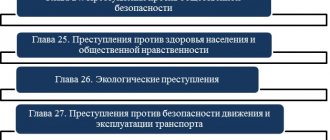Definition of Antisocial Acts
From the name itself we can conclude that these are those actions that contradict the norms and rules established by law and society, as they can cause significant harm.
Antisocial activities include drinking alcohol, using drugs, prostitution, vagrancy and begging.
Antisocial actions include the use of alcohol or intoxicating substances by minors, prostitution, vagrancy or begging, that is, everything that violates the rights of citizens or causes them harm.
Definition of Engagement
As we have already found out, an antisocial act is something that clearly violates the existing law, and therefore the rights of citizens.
Important! Involving a teenager in such actions means psychological or even physical influence on him in order to obtain the result desired by the criminal. This can lead not only to serious and often irreversible changes in the child’s psyche, but also significantly affects society itself.
Also, children who use alcohol or drugs drop out of school and often do not resume it, which leads to the degradation of society and a decrease in the level of education. They may begin to commit more serious offenses in the future. Therefore, this problem is strictly controlled by law.
Particular attention is paid to those situations where parents or those persons who are responsible for raising and educating children are involved in such acts.
Composition of the crime under the article
The corpus delicti is formal in its design. The crime is considered completed at the moment the teenager is involved in any act contrary to the law, regardless of whether it took place or not.
The main object of this offense is social relations that arise in connection with the mental, spiritual and physical development of a citizen and ensuring his legal right to a decent existence. Additional objects determine the life, health, honor and dignity of adolescents and children.
The subject of this act is often an adult who is fully aware of the negativity of his act.
The subject of the act is a capable citizen who has crossed the threshold at 18 years of age. According to Part 2, it is defined as special - these are teachers, parents, educators, that is, persons responsible for the upbringing of adolescents and children.
Objective and subjective sides
The objective side is the actual involvement of adolescents and children in committing acts that are clearly illegal.
The subjective side determines guilt in the form of direct intent , since the person inciting a teenager to engage in illegal actions is fully aware and wants his actions to have their negative consequences.
Concept, signs and types of offenses
In general terms, an offense is an antisocial act (action or omission) that causes harm to society and which is punishable in accordance with the law.
Illegal behavior (offense) violates the requirements of legal norms and harms society as a whole; it complicates and disorganizes the development of social relations.
For example, the Criminal Code of the Russian Federation provides for crimes that encroach on the foundations of the state system, on the individual, his political, economic and social rights, public order and other social benefits. There are offenses that are not so socially dangerous, but taken together they can pose a significant danger.
In our country, in modern conditions, there is a surge in crimes, especially crimes in various spheres of public life, which creates a threat to the state and society, the life, health and property of citizens. Therefore, it is very important to combat crimes to determine their nature and characteristics, the reasons for their commission, and then outline ways to reduce them.
An offense is the guilty, illegal behavior of a person that infringes on the interests of society, the individual and entails the application of measures of public influence or state coercion to the person who committed it. An offender, when committing offenses, encroaches on social relations protected by law, causes harm to society (this was discussed above), and his actions are recognized as socially dangerous.
The offense is characterized by four main features: -
public danger; —
illegality; —
guilt; —
Punishability.
Let us consider these signs of an offense in more detail.
Public danger is a sign of an offense, which consists of causing harm to the legitimate interests of the individual, society and the state. Public danger is characterized by two indicators: -
the nature of the public danger (qualitative sign); —
degree of public danger (quantitative sign).
According to the degree of public danger, offenses can be divided into two groups: 1)
crimes (criminal offences); 2)
unlawful offenses (administrative offenses, disciplinary offenses, civil offenses - torts).
Crimes differ from misdemeanors in that they have a high degree of social danger, which is determined by the value of the object of the attack, the amount of damage caused, and the degree of guilt of the offender. Thus, a crime is a socially dangerous act prohibited by criminal law, encroaching on relations especially protected by the state: social order, personality, property, public order, etc.
Crimes are those acts that are directly provided for by the Criminal Code of the Russian Federation and committed by capable, sane persons, that is, those who have reached the legal age (14-16 years) and are able to account for their actions and direct their actions.
An offense is characterized by the manifestation of the will of a person who can act reasonably, therefore offenses committed by minors and mentally ill people are not considered crimes.
Illegal acts not directly provided for by the Criminal Code of the Russian Federation refer to another type of offense - unlawful misdemeanors.
Misdemeanors (unlawful misdemeanors) are offenses characterized by a lesser degree of public danger.
Depending on the nature of the harm caused, the object of the offense and the characteristics of the corresponding sanctions, unlawful offenses are divided into administrative, disciplinary and civil offenses.
Administrative offenses are offenses that infringe on public order established by law (violation of traffic rules, fire safety, sanitary hygiene, etc.).
d.).
Disciplinary offenses are illegal violations of labor, service or educational discipline.
Civil offenses (delicts) are offenses committed in the sphere of property and non-property relations that are of spiritual value to a person, that is, non-fulfillment or improper fulfillment of undertaken obligations, the infliction of this or that property damage by one or another entity.
Unlawfulness is a normative sign of an offense, which establishes the prohibition of socially dangerous acts, that is, socially dangerous acts directly provided for by the rules of law are recognized as offenses.
There are several types of illegality (as a legal expression of public danger): -
disciplinary; —
administrative; —
civil law; —
criminal
Circumstances excluding the wrongfulness of an act are: -
necessary defense - proportionate protection from unlawful attacks by causing harm to the offender; —
extreme necessity - action to eliminate danger by causing harm to third parties; —
detaining a person who has committed an offense by causing proportionate harm in case of resistance.
Guilt is a subjective sign of an offense that expresses a person’s internal attitude towards a socially dangerous act and its consequences in the form of intent or negligence. According to this criterion, an offense is recognized as an unlawful act committed guiltily, that is, consciously (acts committed by incompetent and insane persons are not crimes; these persons are not capable of acting guiltily). If a person did not foresee the occurrence of socially dangerous consequences (should not or could not), there is an incident or a case without guilt.
Punishability is a sign of an offense that expresses its negative state assessment as a dangerous, illegal, guilty act.
An offense is an act for which legal liability is provided in the form of criminal punishment, disciplinary, administrative or property penalties.
Related topics:
- Validity period of a Russian passport How to determine the validity period of a citizen’s passport by the main event that affects the validity period of the document...
- Conclusive actions CONCLUDENT ACTIONS See what “CONCLUDENT ACTIONS” is in other dictionaries: Conclusive Actions - See Actions...
- Validity of writs of execution When the debtor has not received a writ of execution Let us assume that a court decision became the reason for the FSSP to issue a writ of execution,...
Qualifying features - what actions can be confused with
It should be noted that the motive and purpose of committing this crime are not particularly important for its qualification. The same applies to whether or not the teenager succumbed to provocation from an adult. The crime is considered committed at the moment when he has already tried to do it.
Peculiarities. Regarding the last point, there is some disagreement on the part of legislators and lawyers, since some of them believe that this offense should be considered completed when the teenager began to commit the actions to which he was encouraged.
Sometimes this crime is confused with a completely different one, which is interpreted in Art. 150 of the Criminal Code of the Russian Federation. However, it clarifies that under this article, preventive measures are prescribed only in cases where adults involve a child or teenager in committing crimes.
If antisocial actions of minors are those actions that do not fit into the framework of the law and can cause harm to society, then a crime is an act that carries a high degree of danger to citizens, and also involves significant damage to law and order.
This is the difference between these two atrocities.
Arbitrage practice
Law enforcement and judicial practice in the investigation of crimes under Art.
151 of the Criminal Code of the Russian Federation allows us to identify a number of shortcomings for 2021. The fact is that such acts are traditionally considered by investigators as “additional” to the main offenses (hijacking, theft) for which criminal cases are initiated. It is very difficult in court to prove the guilt of adults who involve teenagers in committing antisocial acts, which is due to many reasons.
The accusation is based mainly only on the testimony of the accused himself and the teenager, not supported by other evidence, which ultimately leads to the acquittal of adults by the court under Art. 151 of the Criminal Code of the Russian Federation.
Teenagers often refuse their testimony under pressure from an adult, and the presence of mental pressure on a minor from an adult requires a detailed analysis of their relationship, the mechanism of their conspiracy; At the same time, investigators underestimate the moment of efficiency in the investigation process.
During the investigation, it is necessary to take into account the fact that a teenager involved in committing atrocities can take on someone else’s guilt, demonstrating himself as the initiator of the crime.
Such behavior is associated with the psychological characteristics of minors: the lower their intellectual development, the more this is manifested. The reason for many acquittals in this crime is the fact that investigators and interrogators did not pay due attention to establishing all the circumstances of teenagers’ involvement in antisocial actions and in the absence of direct evidence of this.
All this explains the significant number of acquittals in trials where crimes under Art. 151 of the Criminal Code of the Russian Federation. In approximately 90% of cases, the defendants were acquitted of the charges under this article .
Thus, we can say with confidence that the practice of investigating criminal cases under Art. 151 of the Criminal Code of the Russian Federation for a number of years and to this day is at a fairly low level and requires improvement.
Case 1
Thanks to the work of the traffic police inspector, it turned out that a certain adult S, who had previously had problems with the law, but got off with a suspended sentence, repeatedly suggested that the minor Z try intoxicating substances.
In particular, breathe in the vapors of the stain. During the investigation that began, it was established that S knew about J’s minority, but this did not stop him.
During the inspection of home C, bags with liquid residues and containers for a product intended for painting surfaces were found.
After the trial, S was sentenced to 3 years in prison and sent to a maximum security colony.
Case 2
The mother forced her daughter to beg, having previously explained which people should be approached, how to behave and what to say.
During the court hearing, the mother did not deny guilt and repented. For involving her daughter in antisocial behavior, the mother was sentenced to a year of suspended imprisonment, with a probationary period of one year.
People who are “lost” to society, without a twinge of conscience, “instill” their harmful habits in the minors they know.
It does not matter how such individuals motivate their behavior, however, it is prosecuted by law if the fact of involvement in antisocial action is revealed.
Criminal liability
According to Art. 151, various preventive measures may be prescribed, but the specific punishment is determined based on the part by which the incident is classified.
If it was determined according to the first part, then the court may assign the citizen such preventive measures as:
- compulsory work for 480 hours;
- correctional labor for 1-2 years;
- arrest for 3-6 months;
- imprisonment for 4 years.
According to Article 151 of the Criminal Code of the Russian Federation, a citizen can be sentenced to compulsory labor, arrest, imprisonment, etc.
The second part of this article provides for the following penalties:
- restriction of a citizen’s movements for 2-4 years;
- arrest for 4-6 months;
- imprisonment for 5 years with a ban on holding certain positions or activities for 3 years or without the use of the last sanction.
According to the third part, a citizen is subject to a preventive measure in the form of imprisonment for 2-6 years with restriction of the person’s movements for 2 years or without applying the latter punishment.
What punishment faces in 2021?
The type of punishment depends on the classification of the crime. For a crime under Art. 151 of the Criminal Code of the Russian Federation The following types of punishment may be applied to the accused:
- up to 480 hours of compulsory work;
- from 1 to 2 years of correctional labor;
- from 4 to 6 months of arrest;
- from 2 to 4 years of restriction of freedom;
- up to 6 years of imprisonment (under Part 3 of Article 151 of the Criminal Code of the Russian Federation);
- prohibition from conducting certain activities for 3 years.
A parent who involves a teenager in vagrancy due to difficult life circumstances caused by lack of a place of residence or loss of a source of livelihood is not subject to criminal liability.
How to prove the fact of lack of involvement
Paragraph 8 of the Resolution of the Plenum of the Armed Forces of the Russian Federation No. 7 exempts an adult citizen from criminal liability under this article if he was not aware that he was involving a teenager in illegal actions, or had no idea about the real age of the child.
Also in the note to Art. 151 of the Criminal Code of the Russian Federation states that the fact of involvement in vagrancy is absent in cases where a teenager is forced to wander on the street with his family due to the latter’s distress. In this case, you should provide any papers that confirm this fact.







